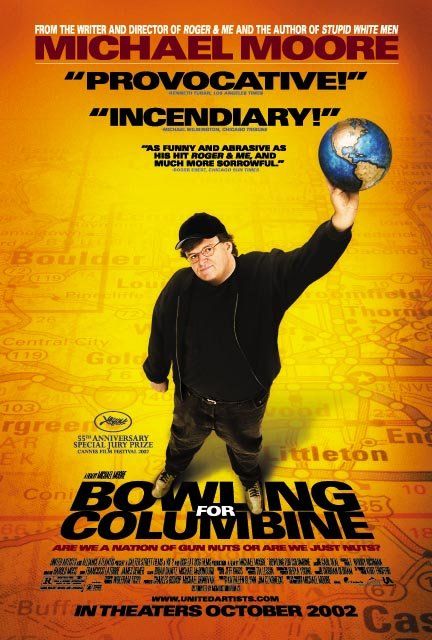"Bowling Causes Violence In America?"

| None | Light | Moderate | Heavy | |
|---|---|---|---|---|
| Language | ||||
| Violence | ||||
| Sex | ||||
| Nudity |
What You Need To Know:
BOWLING FOR COLUMBINE is an example of socialist propaganda. It is the kind of movie that was made in the Soviet Union and is still being made in Communist China today. In lambasting American society, American foreign policy, American political leaders, and the National Rifle Association, Moore fails to mention the mass murders in the Soviet Union, China and Cambodia under totalitarian Communist regimes. He also lets Hollywood off the hook, even though countless studies clearly show that violence in the entertainment media causes violence in real life. Moore also neglects to mention the studies showing that other nations are not so peaceful as Moore suggests and the fact that gun control actually increases violent crime.
Content:
(HHH, PCPCPC, AcapAcapAcap, SoSoSo, RHRHRH, L, VVV, M) Very strong humanist, politically correct worldview, with strong political criticism of American society, economy and foreign policy, anti-Capitalistic, pro-socialist, cynical treatment of American leaders of both parties, and graphic depiction of past American bloodshed with sweeping generalizations about the American love of bloodshed born of fear and racism, and sarcastic, far-ranging sweep of American life using numerous film-clips and ads, balancing materials are not presented and argument is lopsided and inconsistent with the general consensus of American life; 3 obscenities; footage includes Columbine murders seen on school cameras, live executions and second plane hitting World Trade Center; and, several entrapping and confrontational interviews recorded live.
More Detail:
BOWLING FOR COLUMBINE – a documentary by Michael Moore. About what? The shooting at the Littleton, Colorado high school on April 20, 1999? Not really. The tragic drama claims less than 20 minutes of the two-hour-plus movie. More attention is given to Flint, Michigan, the writer-producer-director-star’s home town, which he immoralized in his first movie, a personal exposè of the evils of the General Motors plant that allegedly exploited the working class of that rust-belt town. Actually, Flint received mention for its proximity to the Michigan Militia, where the Nichols brothers, sidekicks of executed Oklahoma City bomber Timothy McVeigh, trained.
Ironically, one of the mass murderers at Columbine had actually lived in Flint earlier when his father learned about mass destruction from the Air Force base nearby. Flint surfaces again as the unfortunate site of the accidental murder of a six-year-old by a classmate who brought his uncle’s gun to school. A documentary about a shooting? It’s not that at all, but a two-hour political statement that clearly raises Moore’s question: Why is there so much violence in American society?
The first hint of Moore’s answer suggests his answer: the omnipresence of guns in America featured in video games, pop culture, television shows, and children’s games and protected by the National Rifle Association and the Second Amendment. Moore cleverly juxtaposes scenes from local TV coverage of gun crimes with gun advertisements, and stand-up comic clips. Def Jam comic Chris Rock’s answer was “Gun control? All we need is bullet control. If a bullet cost $5,000 a bullet, there would be no innocent bystanders hit!” Moore’s quick cynicism does not stop with lampooning the gun owners and gun lovers whom he sometimes allows to speak for themselves. Unfortunately, missteps in their words were emphasized while more reasonable warnings and disclaimers were slighted or edited out.
After suggesting that Charlton Heston was insensitive to Columbine, Flint and other tragedies with clips from his ads and speeches, Moore interviewed Heston in his home by stressing his life-time membership in the NRA. Contrary to his credentials, Moore unsuccessfully asked the actor to apologize to the people of the towns involved for his visits there so soon after the tragedies to promote gun ownership. Thus entrapped, Moses parted.
Also entrapped by Moore with an embarrassing accusation as he was getting in his van was music promoter Dick Clark. His Michigan restaurant employed Tamarla Owens, the single parent who was under-paid and evicted, causing her six-year-old to get access to his uncle’s gun in Flint. The K-Mart national office did not fare much better when confronted by two of the wounded from Columbine. Moore took them with bullets still in their bodies to return the merchandise the killers had bought from that chain. Moore takes pride in the K-Mart decision to discontinue ammunition within 90 days.
The question about American violence is a critical one, but the “documentary” reduced to the ridiculous some of the more conservative answers, giving the Christian Right a millisecond head shot of Jerry Falwell exclaiming “Satan!” Moore moves much further in laying the blame for American bloodshed, and he paints with a very broad brush indeed. In the movie, he smears American military actions, the defense industry, violent video games, television news coverage, poverty, government welfare cuts, racism, and all the other alleged evils constantly recited by the left.
Omitted almost completely from this diatribe was the film industry. Even Heavy Metal music was allowed to defend itself with an interview by shock rocker Marilyn Manson. Less sympathetically treated interviewees included the manager of the Lockheed Martin plant in Columbine where missiles are made.
BOWLING FOR COLUMBINE is not family fare. Live footage shows people executed on camera and the bodies of people assassinated by the CIA and other American supported regimes. Ironically, no mention is made of the Killing Fields of the Khymer Rouge and the millions killed by Stalin or systems that Moore protects. Moore even shows the footage of the second jetliner hitting the twin Towers, crediting the evils to the CIA’s training of Osama Bin Laden. Not omitted, nor necessarily related, was the fact that the USA dropped the most bombs on Kosovo on the same day as Columbine. The killers are shown on the school security cameras chasing the students from the rooms and standing over student bodies. Several obscenities by Moore and other people are also used in the interviews.
On the intolerant side, Moore uses a cartoon version of American history emphasizing fear of black people by whites fleeing to the suburbs that more than approaches reverse racism. The unrealized scare a few years ago of “Africanized” killer bees moving north only shows the manipulation of those fears.
After an unfair, disingenuous comparison of the United States death by gun rates with other countries, Moore concludes that the U.S. is a society in the grip of fear, mobilized by the “if it bleeds, it leads” coverage and advertising appeals. Yet, this fear and racism do not exist in Canada, he asserts, where there are perhaps seven million guns among 10 million families. Why do Toronto residents not lock their doors? Because they get free medical help from the government!
In Moore’s movies, those who share his views would agree, the overweight, unkempt filmmaker is the hero. Regrettably, his victims are the viewers. Does he not see that the Canadian numbers nullify his gun argument? The answer to violence in America cannot exclude mention of the “entertainment industry” where heroes blow away their enemies with automatic weapons with ever increasing bloodshed. In commenting at Cannes, Moore insisted, “Don’t mention violence in films and TV. Any normal American can tell the difference between a make-believe entertainment at 10 p.m. and the real news at 11 p.m.” What if the entertainment industry redefines “normal” and makes heroes of those who blow away their enemies with powerful weapons? If, as the movie states “Columbine is a microcosm of the world,” then we should realize that two crazy students out of 2000 do not tell the whole story.
Where does the “BOWLING” come from in the title? Eric Harris and Dylan Kliebold went bowling before shooting up Columbine and recently three people were killed by gunfire at the Littleton Lanes. Maybe bowling causes violence in America?
Perhaps closer to home is the anger and hatred justified by Moore’s big weapon – his camera lens. The one who has the camera lens and the microphone usually wins the argument, for a while at least.



 - Content:
- Content: 


